Navigation
Install the app
How to install the app on iOS
Follow along with the video below to see how to install our site as a web app on your home screen.
Note: This feature may not be available in some browsers.
More options
You are using an out of date browser. It may not display this or other websites correctly.
You should upgrade or use an alternative browser.
You should upgrade or use an alternative browser.
PO4 Phosphate Test Kit Shoot out: NYOS Elos Pro Salifert Hanna Checkers Seachem
- Thread starter jason2459
- Start date
- Tagged users None
- Joined
- Sep 22, 2015
- Messages
- 576
- Reaction score
- 176
I cant get my phosphate down it is .25 I have tried everything I have hair algee like crazy im about ready to quite and go back to freashwater
I cant get my phosphate down it is .25 I have tried everything I have hair algee like crazy im about ready to quite and go back to freashwater
And I can't get po4 up from 0. The joys of reefing.
Randy Holmes-Farley
Reef Chemist
View Badges
Staff member
Super Moderator
Excellence Award
Expert Contributor
Article Contributor
R2R Research
My Tank Thread
- Joined
- Sep 5, 2014
- Messages
- 67,516
- Reaction score
- 63,953
I cant get my phosphate down it is .25 I have tried everything I have hair algee like crazy im about ready to quite and go back to freashwater
What problems is it causing?
Have you tried a phosphate binder, like GFO? That should always drop phosphate low enough if you use enough and change it often enough.
- Joined
- Sep 22, 2015
- Messages
- 576
- Reaction score
- 176
Causing algee and I am using a phosphate pad but its doing nothing I have used GFO and it did t go down I have been usi g it in a canister filter maybe I need to ttry a reacter do you think that would make a difference?
Randy Holmes-Farley
Reef Chemist
View Badges
Staff member
Super Moderator
Excellence Award
Expert Contributor
Article Contributor
R2R Research
My Tank Thread
- Joined
- Sep 5, 2014
- Messages
- 67,516
- Reaction score
- 63,953
Causing algee and I am using a phosphate pad but its doing nothing I have used GFO and it did t go down I have been usi g it in a canister filter maybe I need to ttry a reacter do you think that would make a difference?
It can work better that way, yes. If you want to go without a reactor, you might try larger media, like Seachem Phosguard.
- Joined
- Jul 28, 2015
- Messages
- 4,668
- Reaction score
- 3,191
If I had phosphate issues well over .2 I would take a few steps to reduce those down to manageable levels.
1. Lanthanum Chloride. GFO at very high levels of PO4 will be exhausted very very quickly. PhosFree I think the product I used was called, not the commercial grade it's not safe. I used it dripping into a diatom filter that filters down to 1micron to catch the precipitated phosphates. I did this over a few days period to get the phosphates down to around .1
2. GFO at this level can keep up much better and reduce very easily to under .1 assuming you don't have major rock leaching issues which then Lanthanum Chloride can be used again.
3. Algae. If algae is not being harvested in some way I would incorporate this. Chaeto or some kind of macro algae in a refugium. Or an Algae turf scrubber (ATS). You can make or implement both fairly cheaply. I've been using a Turbo Aquatics ATS and have been extremely happy with it.
4. Carbon dosing with a good skimmer. I believe this to be my number one method of nutrient control for both Nitrates and and Phosphates. Though this is really only good for helping to maintain lower phosphates. You have to get them down to a maintenance level first. Some may still need to implement GFO but that GFO will last a lot longer now the levels are manageable and other methods are in place to help control them.
5. Water change. This is my catch all. Import stuff and export stuff. It's not very efficient at all at maintaining or lowering run away nutrients. I took Randy's advice and have always made water changes as simple as possible to insure that I do them. In the past couple years I made them even easier by setting up an automatic water change system that changes out around 1% daily.
1. Lanthanum Chloride. GFO at very high levels of PO4 will be exhausted very very quickly. PhosFree I think the product I used was called, not the commercial grade it's not safe. I used it dripping into a diatom filter that filters down to 1micron to catch the precipitated phosphates. I did this over a few days period to get the phosphates down to around .1
2. GFO at this level can keep up much better and reduce very easily to under .1 assuming you don't have major rock leaching issues which then Lanthanum Chloride can be used again.
3. Algae. If algae is not being harvested in some way I would incorporate this. Chaeto or some kind of macro algae in a refugium. Or an Algae turf scrubber (ATS). You can make or implement both fairly cheaply. I've been using a Turbo Aquatics ATS and have been extremely happy with it.
4. Carbon dosing with a good skimmer. I believe this to be my number one method of nutrient control for both Nitrates and and Phosphates. Though this is really only good for helping to maintain lower phosphates. You have to get them down to a maintenance level first. Some may still need to implement GFO but that GFO will last a lot longer now the levels are manageable and other methods are in place to help control them.
5. Water change. This is my catch all. Import stuff and export stuff. It's not very efficient at all at maintaining or lowering run away nutrients. I took Randy's advice and have always made water changes as simple as possible to insure that I do them. In the past couple years I made them even easier by setting up an automatic water change system that changes out around 1% daily.
- Joined
- Sep 22, 2015
- Messages
- 576
- Reaction score
- 176
Thank you I will give it a try
I tested my water with the Hanna Checker URL for Phosphates and I got ZERO, is that possible? I do have a media reactor running BRS GFO High Capacity.
Randy Holmes-Farley
Reef Chemist
View Badges
Staff member
Super Moderator
Excellence Award
Expert Contributor
Article Contributor
R2R Research
My Tank Thread
- Joined
- Sep 5, 2014
- Messages
- 67,516
- Reaction score
- 63,953
I tested my water with the Hanna Checker URL for Phosphates and I got ZERO, is that possible? I do have a media reactor running BRS GFO High Capacity.
Yes, bearing it has some inherent potential error. Which model checker? Depending on the model, it need not be very low to read none.
I have the Ulr Hanna checker.. Ok, now I really could use your help Randy!!
I have a 120 mixed reef tank!! I feed my LPS, SPS AND SOFT CORALS - BRS Reef Chili and my Dr G's Photoplankton ON M-W-F ONLY and my sps and lps corals were doing great. Then I started adding REDSea Reef Energy A ( Carbs Nutrition) and Reef Energy B (Aminovit).. - 5MLS EVERY OTHER DAY....Ever since i started using these two products I have lost two SPS corals... Also, I dose 25mls of Alk, Cal and MAG every day through my Eshopps doser and that is it.. I do a weekly water change of 10 gallons every week. Would love to hear your thoughts on what to do? or what I am doing worng..
Here are current parameters:
ALK:8.5 dKH
CAL: 400
MAG: 1250
Nitrate: 0
Phosphates: 0.03
Salinity: 1.025
Temp: 78.9
Lighting Schedule with two AI Hyrda TwentySix HD LEDS which are 18'' off the water and about 20'' from the coral:
I have them running from 3pm till 10pm on the following settings with a 1hr ramp up time and a 1hr ramp down..
UV: 100%
Violet: 100%
Royal Blue: 100%
Blue: 67%
Green: 20%
Red: 20%
Cool White: 60%
Setting from 10pm till 2:00pm to mimic the moon.
UV: 0%
Violet: 0%
Royal Blue: 1%
Blue: 1%
Green: 0%
Red: 0%
White: 0%
TANK INFO:
120 Mixed Reef
Ecotech M1 pump
Skimz 163 DC Montzer Series skimmer
Custom sump / Refuge
2 Maxspect Gyre XF130's Pumps
2 AI Hydra TwentySix HD LED Fixtures
Celestial C35W Maxspect Refuge Spotlight
Aqua UV Ultraviolet Sterilizer 25w
BRS Dual Media reactor
Eshoops IV Master & Slave Doser
Tunze 3155 Auto Top Off
This is what I have in the tank.
2 small Ocellaris Clownfish
Purple Stripe Dottyback
Powder Blue Tang
Yellow Tang
Blue Caribbean Tang
2 Spotted Cardinalfish
Yellowtail Damselfish
2 Blue/Green Reef Chromis Chromis
Corals / LPS, SOFT AND SPS:
1. SPS - 2 - Galaxia Frags
2. SPS - Stylophora sp. ReefGen Milka Stylo Frg - that's not looking good / turing white.
3. SPS - Acropora / Millepora Green Millie
4. SPS - Acropora / Dark Green
5. LPS - Torch Coral / Green
6. LPS - Hammer Frag / Green
7 LPS - FropSpawn Frag
8. LPS- Favia Coral Green
9. 4 Orange Sponges
10. LPS - OctoSpawn
11. LPS - Frogspawn
I have a 120 mixed reef tank!! I feed my LPS, SPS AND SOFT CORALS - BRS Reef Chili and my Dr G's Photoplankton ON M-W-F ONLY and my sps and lps corals were doing great. Then I started adding REDSea Reef Energy A ( Carbs Nutrition) and Reef Energy B (Aminovit).. - 5MLS EVERY OTHER DAY....Ever since i started using these two products I have lost two SPS corals... Also, I dose 25mls of Alk, Cal and MAG every day through my Eshopps doser and that is it.. I do a weekly water change of 10 gallons every week. Would love to hear your thoughts on what to do? or what I am doing worng..
Here are current parameters:
ALK:8.5 dKH
CAL: 400
MAG: 1250
Nitrate: 0
Phosphates: 0.03
Salinity: 1.025
Temp: 78.9
Lighting Schedule with two AI Hyrda TwentySix HD LEDS which are 18'' off the water and about 20'' from the coral:
I have them running from 3pm till 10pm on the following settings with a 1hr ramp up time and a 1hr ramp down..
UV: 100%
Violet: 100%
Royal Blue: 100%
Blue: 67%
Green: 20%
Red: 20%
Cool White: 60%
Setting from 10pm till 2:00pm to mimic the moon.
UV: 0%
Violet: 0%
Royal Blue: 1%
Blue: 1%
Green: 0%
Red: 0%
White: 0%
TANK INFO:
120 Mixed Reef
Ecotech M1 pump
Skimz 163 DC Montzer Series skimmer
Custom sump / Refuge
2 Maxspect Gyre XF130's Pumps
2 AI Hydra TwentySix HD LED Fixtures
Celestial C35W Maxspect Refuge Spotlight
Aqua UV Ultraviolet Sterilizer 25w
BRS Dual Media reactor
Eshoops IV Master & Slave Doser
Tunze 3155 Auto Top Off
This is what I have in the tank.
2 small Ocellaris Clownfish
Purple Stripe Dottyback
Powder Blue Tang
Yellow Tang
Blue Caribbean Tang
2 Spotted Cardinalfish
Yellowtail Damselfish
2 Blue/Green Reef Chromis Chromis
Corals / LPS, SOFT AND SPS:
1. SPS - 2 - Galaxia Frags
2. SPS - Stylophora sp. ReefGen Milka Stylo Frg - that's not looking good / turing white.
3. SPS - Acropora / Millepora Green Millie
4. SPS - Acropora / Dark Green
5. LPS - Torch Coral / Green
6. LPS - Hammer Frag / Green
7 LPS - FropSpawn Frag
8. LPS- Favia Coral Green
9. 4 Orange Sponges
10. LPS - OctoSpawn
11. LPS - Frogspawn
First up is my current favorite and go to. The Hanna 736 ULR ppb Phosphorus Checker. I feel I get consistent results and accurate enough for tracking my phosphates and to know I'm in my target range. But I'm not going to be so close minded that there can't be or hasn't been issues with this checker for other people.
BeanAnimal did an excellent review on it as well. He wasn't so impressed and experienced issues with bad reagents. Which can be an issue with any test kit of any brand for any kind of test.
http://www.beananimal.com/other/hanna-hi-736-checker-hc-opinion.aspx
Cost wise its upfront cost is more then some others at around $40-$50 but the long term cost is reduced by being able to just buy the reagents for like $8 for 25 packets.
This technically is a phosphorus checker so to get the phosphate numbers we commonly look for and recommended to be at around .03ppm or below there's some math to be done. There's a chart in that link above already breaking it down or just remember to
Number in ppb x 3.066 and then divide that by 1000 and you will get close enough to what you are looking for with phosphates in ppm.
For accuracy it's pretty good with a range of 0-200ppb, resolution of 1ppb, and an accuracy of ±5 ppb ±5%. Which is really pretty good if it matches what's advertised.
Which Hanna sells what they call a calibration set but you can't really calibrate the Checker. You can however use it to check the accuracy. But there is a flaw with this one in that it uses two vials. Which if there are in flaws and differences between the two vials either initially or over time with use it will cause interference making the readings inaccurate.
I did this "calibration" set for the ULR phosphorus checker and have used it a few times to check accuracy of my particular ULR Checker. So, far I've gotten readings of 98 a few times and 100 a few times. Which is about as good as I could expect to get. The reading is supposed to show 100ppb ±10 ppb or anywhere between 90 and 110. Tonight the reading was spot on 100.
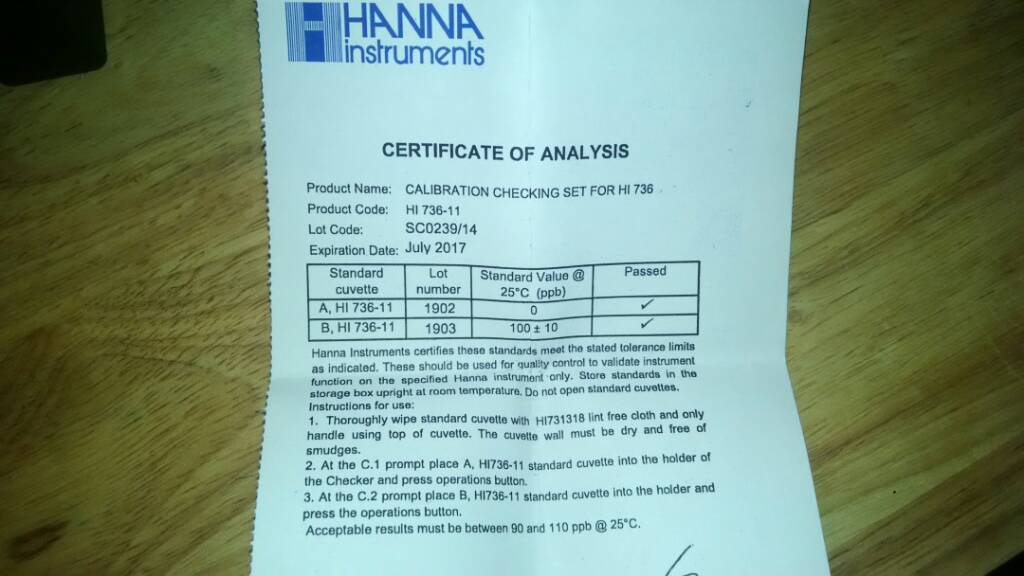
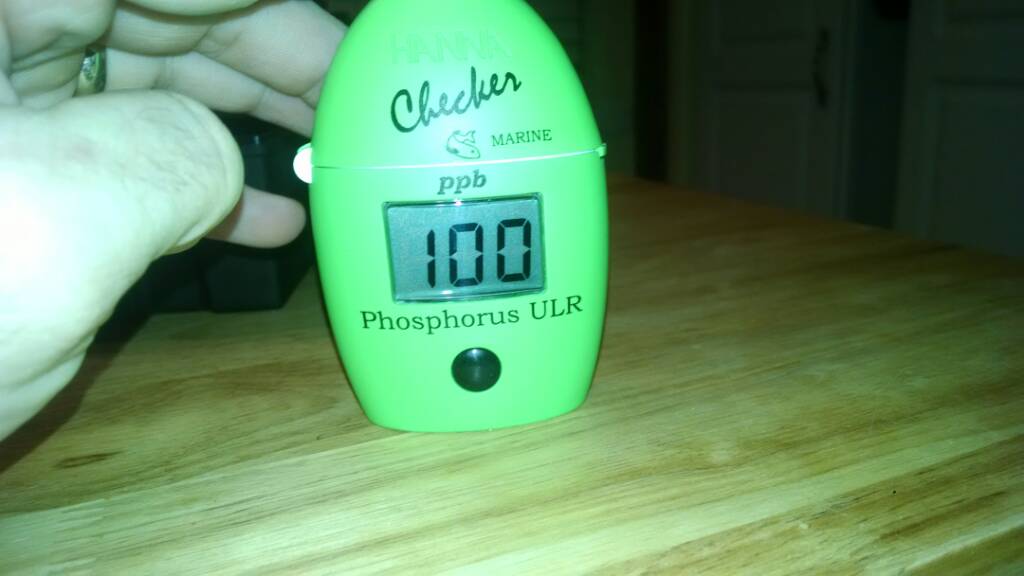
Now for testing my tanks water. I have a pretty good routine down with this checker and do the same with the 713 checker as well.
1. rinse out the vials with tank water several times
2. Fill with 10ml of tank water
3. Get a packet out and flick it a few times to loosen up the powder and move away from the area I'm going to cut in a curved pattern as indicated on the packet (was doing this before they put that indicator on there as well)
4. Set the vial down with tank water and wait for 4-5 minutes doing other stuff
5. Turn the checker on and wait for it to ask for C1
6. Place the vial in with the 10ml mark facing me
7. Cut open the reagent packet and pinch it open so the bottom part is creased to help funnel the powder out into the vial
8. Press the button to read C1
9. As soon as it asks for C2 I pull the vial out (never touching with my fingers at any stage of this using a lint free cloth) and add the reagent
10. Close the vial up and look at the time and gently start mixing the reagent into the water. Taking care not to form bubbles on the insides of the glass.
11. Gently turning over and swirl to mix for 2 minutes.
12. Place sideways and roll the vial to allow air bubble in the vial to remove anything on the sides. Again, never touch the sides with fingers.
13. Press and hold the button for 3 minute timer
14. Place the vial back into the checker with the 10ml mark facing me and wait for the 3 minutes to count down.
I find that the reagent for the ULR 736 checker dissolves a lot better then the 713 Low Range checker. Also the end result value is displayed a lot longer on my 736 ULR checker.
And the results tonight are on target with the range I am usually in.
11ppb phosphorous converts to 0.03ppm phosphates.
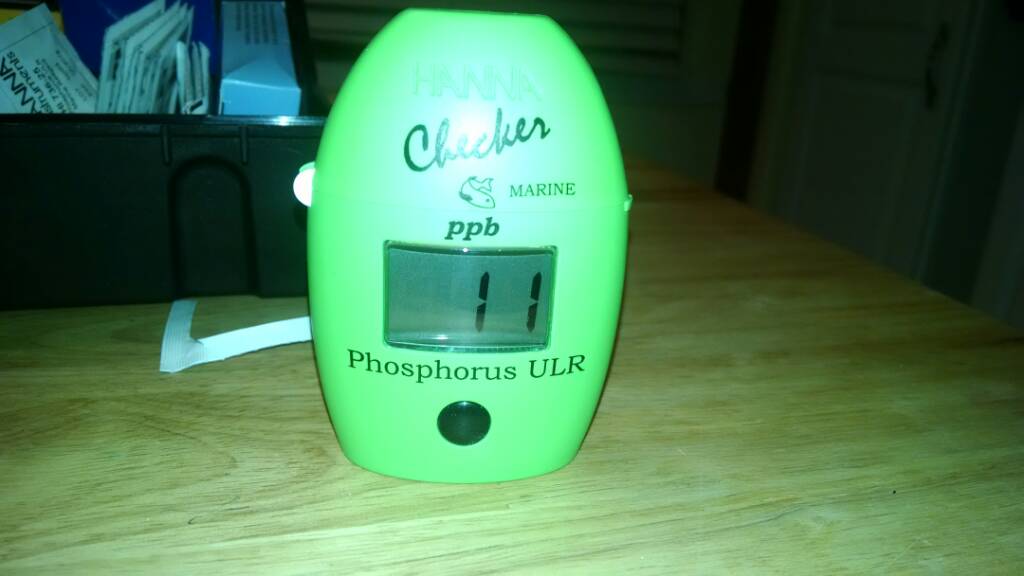
Nice
I was most looking forward to trying this kit out. It's the most expensive out of this group at around $45-$50 but has gotten several really good reviews. But I was let down by the Nyos Nitrate in my last shoot out.
The Elos professional phosphate kit has a higher resolution then the none professional version and more expensive to go along with it. The range is certainly there for our needs as advertised:
•Precisely Measure LOW LEVEL Phosphates (between 0.008 and 0.14 ppm)
The kit was setup much like the Nyos kit with an A and B reference vial to drag along a color chart. But the Elos included a much greater range of values on it's color chart (minus seachem being funny with a bunch of individual tick marks.) The colors went from shades of yellowish off white to blues.
The execution was pretty easy and straight forward. It did have an extensive 3 minute mixing. But after that was done I found it the easiest of the color chart tests to read. It also came very close to what the Hanne ULR checker came up with.
I got a reading of about 0.024
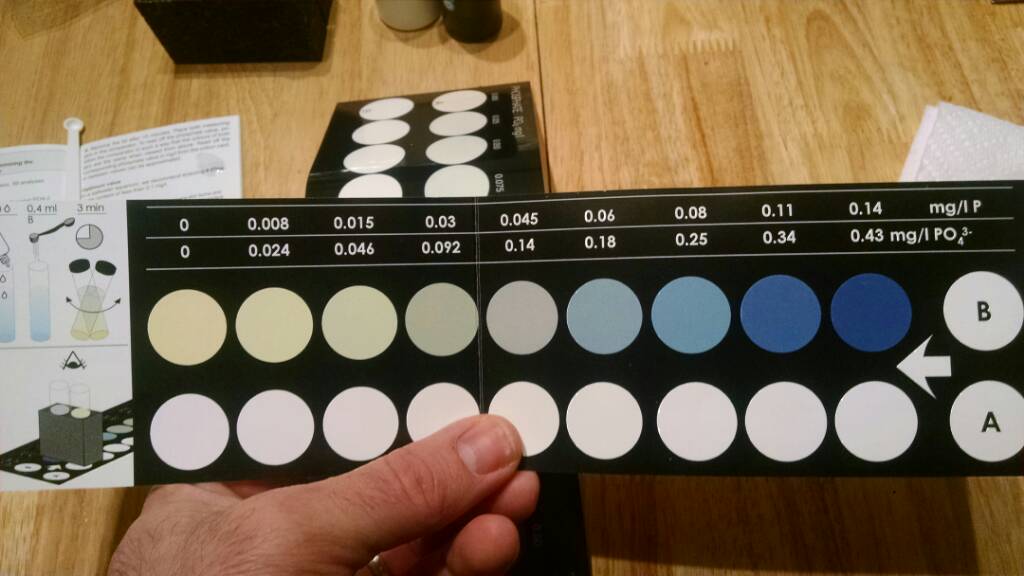
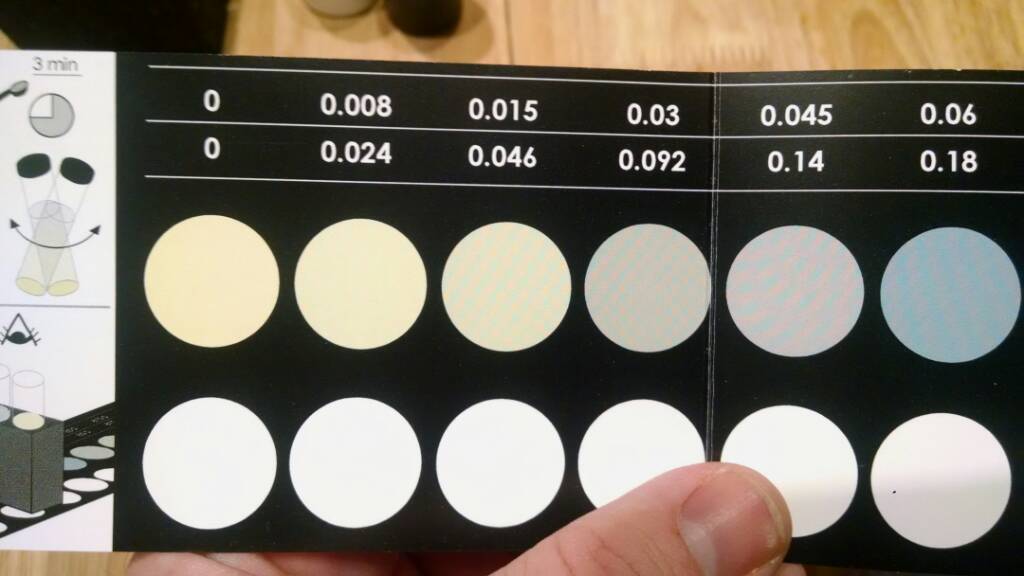
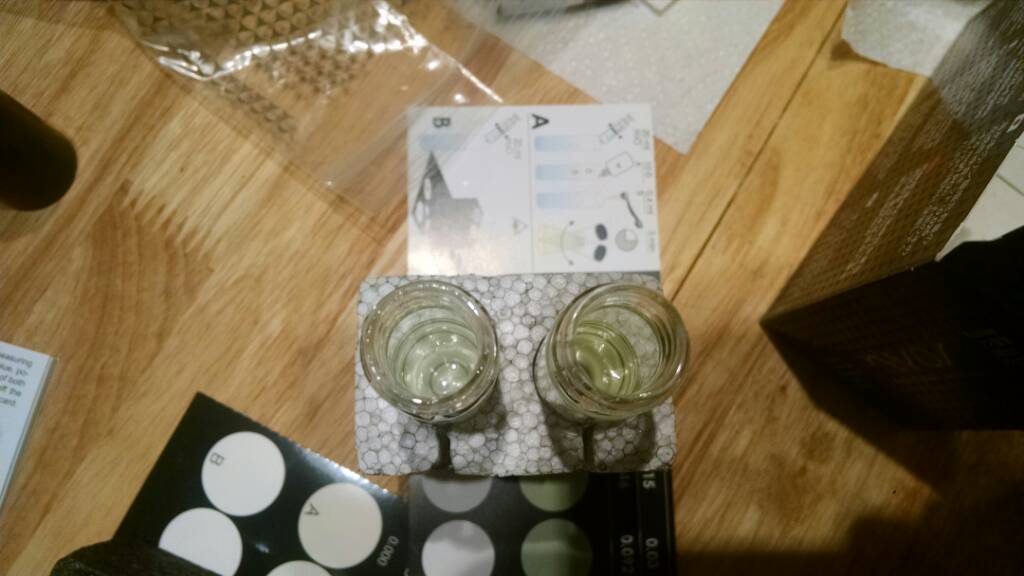
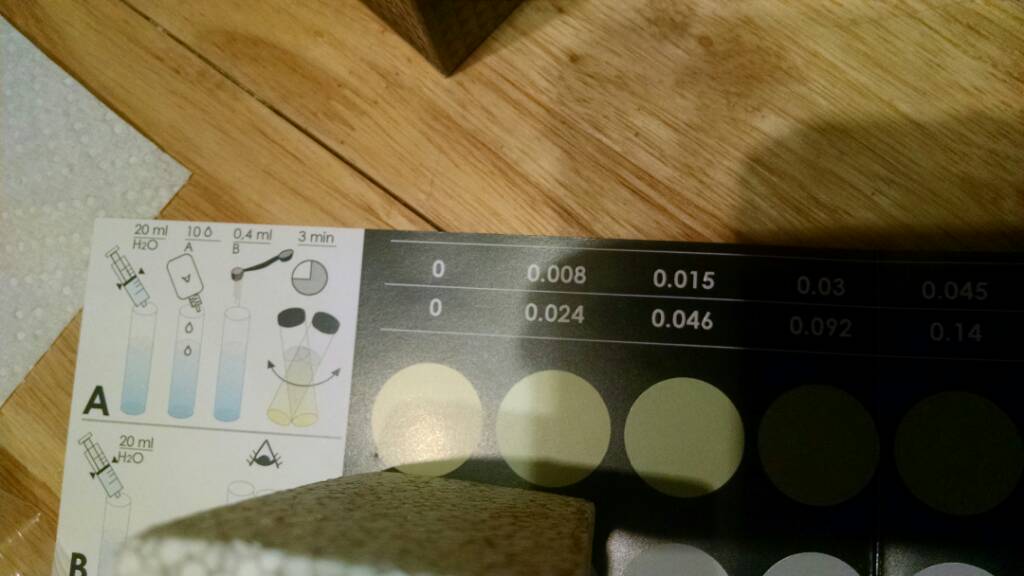
Minus the cost I was very happy with this kit. It was easy to use. Fairy quick with a 3 minute mixing period. Easy to read but I still see many having issues with this or any of the color matching based test kits. It was a one time use but it matched up to what I've considered a very reliable test with the Hanna ULR Checker so it seems to match up with other's reviews about accuracy.
The cost certainly is a factor though but it's not as much as what I would consider the best PO4 kit we have with-in a hobbyist's budgets reach and that's the Hach PO-19 test kit which is around $100. This Elos kit seems like a fairly good alternative for those wanting a higher resolution kit that's half the cost of the Hach.
Great write-up, check out our brief article explaining the HI713 LR Phosphate Checker and HI736 ULR Phosphorus Checker, please message me about your potential reagent QA issue, I do not recall any such problem occurring with the phosphate reagents. https://www.reef2reef.com/threads/p...hi713-and-hi736-free-conversion-table.317886/
Thanks
Kevin
- Joined
- Apr 9, 2020
- Messages
- 999
- Reaction score
- 244
Hello i just bought this test but I'm not sure to know how to read it as each time they are two numbers? Wich one should i take for exemple ly readings shows 0,045 or 0,14,wich is the good number? The P or PO3-4? How to compare with the hanna checker,what number does the hanna give?I was most looking forward to trying this kit out. It's the most expensive out of this group at around $45-$50 but has gotten several really good reviews. But I was let down by the Nyos Nitrate in my last shoot out.
The Elos professional phosphate kit has a higher resolution then the none professional version and more expensive to go along with it. The range is certainly there for our needs as advertised:
•Precisely Measure LOW LEVEL Phosphates (between 0.008 and 0.14 ppm)
The kit was setup much like the Nyos kit with an A and B reference vial to drag along a color chart. But the Elos included a much greater range of values on it's color chart (minus seachem being funny with a bunch of individual tick marks.) The colors went from shades of yellowish off white to blues.
The execution was pretty easy and straight forward. It did have an extensive 3 minute mixing. But after that was done I found it the easiest of the color chart tests to read. It also came very close to what the Hanne ULR checker came up with.
I got a reading of about 0.024




Minus the cost I was very happy with this kit. It was easy to use. Fairy quick with a 3 minute mixing period. Easy to read but I still see many having issues with this or any of the color matching based test kits. It was a one time use but it matched up to what I've considered a very reliable test with the Hanna ULR Checker so it seems to match up with other's reviews about accuracy.
The cost certainly is a factor though but it's not as much as what I would consider the best PO4 kit we have with-in a hobbyist's budgets reach and that's the Hach PO-19 test kit which is around $100. This Elos kit seems like a fairly good alternative for those wanting a higher resolution kit that's half the cost of the Hach.
Last edited:
Similar threads
- Replies
- 4
- Views
- 143
- Replies
- 4
- Views
- 131
- Replies
- 6
- Views
- 174
















